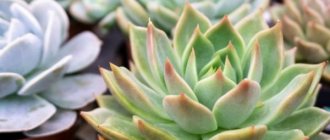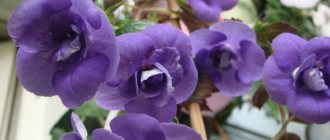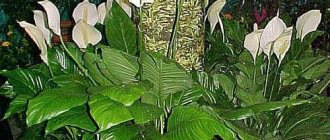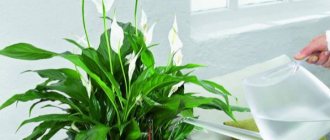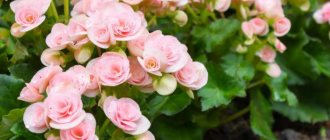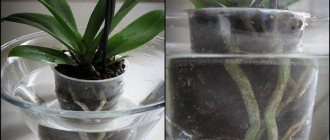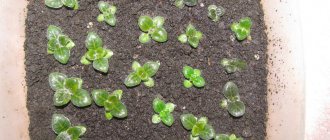Plant varieties with photos
It is important to know that the red color covering the inflorescences of the flower of female happiness is an unnatural phenomenon. The white color turns red due to the chemicals that are introduced into the plant.
What are the names of spathiphyllums that have scarlet inflorescences? Their name is anthuriums or “male happiness”. Below are the varieties of anthurium and photos of them.
Dakota
The most popular species among gardeners . It stands out from all the others thanks to the rather large size of the inflorescence covers - 14 - 23 cm. Spectacular flowers of bright color combined with lush dark green leaves simply cannot be ignored even in a spacious room.
Next is a video about the Dakota variety:
Minnesota
Their distinctive feature is the bracts of a rich scarlet color and the cobs, which are white at the base, gradually turning into bright yellow, sometimes green.
Red
This variety includes many types of anthriums that have very rich bright red or pink covers (for example, Edison).
Dark Red
Their color palette includes all shades from bright red to brown and even black. Burgundy and crimson colors look especially impressive .
Next is a video about the Dark Red variety:
Black queen
Against the background of the almost white spadix, the bract looks almost black. Against a dark background, all the veins stand out very clearly, which makes its appearance even more attractive and impressive.
Next is a video about the Black Queen variety:
History of breeding
The legend of the red spathiphyllum originates in Colombia . The bloodthirsty leader of the tribe noticed a bride from another tribe, but she refused him, and then he ordered his servants to ruin the village and bring the poor girl to him by force.
On the wedding day, the proud girl threw herself straight into the fire in a beautiful red dress as a sign of protest. The gods, seeing this, turned her into a beautiful graceful anthurium.
In Colombia, there is a belief that red spathiphyllum can bring happiness to newlyweds.
Plant breeder
- Home
- Houseplants
- _Various plants
- _
- _Bonsai
- _Bromeliaceae
- _Decorative deciduous
- _
- _Trees and Shrubs
- _
- _Cacti
- _Orchids
- _Ferns
- _Palms
- _Orchard in the apartment
- _
- _Predatory
- _Succulents
- _Blooming
- garden flowers
- _Perennial
- _Annual and biennial
- _
- _Bulbous
- _Roses
- Garden
- _Ornamental trees and bushes
- _
- _Fruit trees and bushes
- _
- _Berries
- _Vegetables
- _Spicy herbs and greens
- _
- _Cereals
- _Greenhouse
- Helpful information
- _Diseases and pests
- _
- _Medicinal plants
- _
- _Reproduction
- _Planting and transplantation
- _
- _Tips for beginners
- _Fertilizers and stimulants
- Mega Menu
In recent years, Spathiphyllum, or as it is more often called, Women's Happiness, has consistently been one of the most popular indoor plants. The flower owes this to both its appearance and its ease of care.
This tall herbaceous plant with wide, pointed leaves of a rich dark green hue can be found in offices, apartments and even country residences.
It is believed that Spathiphyllum has a magical aura that allows girls to find love. The plant is also credited with some healing properties. For example, it helps to cope with diseases of the nervous system and has a beneficial effect on the atmosphere indoors.
Botanical description
Spathiphyllum is a perennial. With proper care, the plant will live with you for several years.
Spathiphyllum does not have a stem as such. The leaves grow directly from the basal rosette. The rhizome itself is short.
The leaf blades are wide in shape, pointed towards the end. In some varieties of the plant, the leaves may be oval or ovoid. The color is rich green, although there are varieties with variegated colors.
INTERESTING! Like all Araceae, the leaves of Spathiphyllum are wide with a thick central vein and clearly visible transverse veins.
During flowering, the plant throws out a long straight peduncle. At its end a white “veil” and an inflorescence in the form of a cob or a short spiky cone are formed. The flowers themselves are very small. Their petals grow together.
Sometimes the “spread” is mistaken for a flower, since it appears on the peduncle once a year and has a different color than the rest of the leaves.
The plant can bloom twice per season: in mid-spring and autumn. But most often it blooms only in spring. An adult Spathiphyllum is capable of throwing out several flower stalks at once.
The fruits of the plant are green berries containing seeds.
IMPORTANT! Few people know that Spathiphyllum is poisonous. Dangerous substances are contained in its leaves. Therefore, when growing a plant at home, make sure that children or animals do not taste it.
History of breeding
The legend of the red spathiphyllum originates in Colombia. The bloodthirsty leader of the tribe noticed a bride from another tribe, but she refused him, and then he ordered his servants to ruin the village and bring the poor girl to him by force.
On the wedding day, the proud girl threw herself straight into the fire in a beautiful red dress as a sign of protest. The gods, seeing this, turned her into a beautiful graceful anthurium.
In Colombia, there is a belief that red spathiphyllum can bring happiness to newlyweds.
Which family does it belong to?
Spathiphyllum represents a large family of Araceae. Almost all plants of this family are distinguished by dense shiny leaves with a clear division into the petiole and the leaf blade itself, an inflorescence-cob and the absence of a clearly defined stem.
Among the Araceae there are lianas and epiphytes. In the natural conditions of the tropics, some plants can reach gigantic sizes.
The general characteristics of the Araceae family are easy to see by comparing Spathiphyllum with Aglaonema, Anthurium or Zantedeschia.
Features and differences from other types
The main difference between red spathiphyllum (anthurium) and other species is the bright red color of the bracts, and the color of the spadix can be white, green and bright yellow. To the touch, the inflorescences of “male happiness” are somewhat harder and denser than those of other species. Also, in anthurium the smell is more pronounced, it can be pleasant, light, and sometimes smelly.
We have prepared a lot of materials about the types of spathiphyllums such as: Silver Cupido, Chopin, Domino, Sweet Chico, Alana, Sensation, Strauss, Wallis, as well as about white spathiphyllums.
Plant structure
Roots
The plant has a shortened rhizome, which it needs to receive nutrients from the soil.
In the wild, Spathiphyllum grows in the tropics on marshy soils. Therefore, at home you need to get closer to the conditions of the plant’s natural habitat.
Spathiphyllum prefers a substrate made of humus, sand and peat. You can prepare the mixture yourself by adding leaf soil and turf. If you are growing a flower for the first time, it is better to purchase a ready-made substrate in the store. Suitable soil for Aroids.
The root system of the plant is very sensitive to the watering regime. You need to add water regularly, but only when the top layer of soil dries. Please note that excessive watering of spathiphyllum causes the water in the pot to stagnate. In turn, this leads to rotting of the root system. The plant dies.
To prevent this from happening, the soil must be loosened. This will ensure air flow to the roots. By the way, the root system of Spathiphyllum is very easy to damage, so be extremely careful.
INTERESTING! Spathiphyllums, epiphytes, are found in the wild. This means that they do not need soil to grow. They can grow, for example, on trees. But all domestic varieties are terrestrial, so they need to be grown in a pot.
Leaves
A distinctive feature of Women's Happiness is its large beautiful leaves. They are mostly dark green, although there are varieties (Picasso, Domino) with variegated leaf blades.
Like most Araceae, the leaves of this plant have distinct petioles, which are approximately equal in length to the leaf blades themselves.
On average, the leaf size of an adult plant is about 50-70 cm. The shape of the leaves of Women's Happiness can be oval, ovoid or lanceolate.
The veins are clearly visible on the leaf plate. The central one is slightly thicker and is like a continuation of the petiole.
INTERESTING! If you notice a drop of water on the tip of a Spathiphyllum leaf, this indicates excessive watering. The soil in the pot under the plant must be loosened and the water must be poured out of the pan.
Cover
During flowering, a white leaf blooms on the long peduncle of Women's Happiness. This is not a flower, but a “veil” that directly covers the inflorescence itself. The “bedspread” is usually a soft white color. It is smaller in size than the main leaves.
INTERESTING! The snow-white blanket gave another name to Spathiphyllum - White Sail.
Flowers
Another distinctive feature of Women's Happiness is its inflorescence. It is a white cream-colored cob. Depending on the variety, the cob may be long and thin or short and thick.
Usually the inflorescence is smaller than the "spread" that surrounds it. However, there are varieties (for example, Spathiphyllum Cannofolia) where the cob is much longer and extends beyond the “spread”.
The inflorescence itself consists of many small flowers. They have fused petals, which makes them seem like some kind of thorns.
When grown at home, Spathiphyllum blooms once per season. Moreover, flowering, starting in mid-spring, can continue until October.
Experienced florists can achieve flowering twice per season. This is for decorative purposes. However, you should not do this to your pet at home. The flower needs a period of rest.
Spathiphyllum “rests” from mid-autumn to early spring. Then the flower will live with you longer.
Reproduction methods
Spathiphyllum red can be grown from seeds.
Quite whimsical flowers with high-quality care are distinguished not only by spectacular flowers, but also by a large number of side shoots. A rather advantageous feature of red spathiphyllum is that it can be grown from seeds. However, in order for them to form, it will be necessary to take care of this initially.
It is necessary to carry out the process of pollination of flowers. It involves the transfer of pollen from one flower to another. To perform this operation, you will need a swab with a cotton tip or a brush with a certain softness. Pollination manipulations should be repeated several times over several days. Patient housewives will wait for the formation of colorful berries 10-11 months after the operation. However, in this matter you should still be patient until the seeds form.
To do this, the seeds need to be removed from the berries and washed under running water. Then you should make a 0.1% solution of potassium permanganate. Seeds are sent into it to prevent mold from growing on them. They should remain in the solution for 2 hours.
Since the seeds lose their ability to germinate within a short time, they must be sent to a shallow container, the bottom of which is covered with slightly damp foam rubber. The top of the vessel should be covered with a plastic bag or glass lid. After germination, the seeds need to be planted. This procedure must be performed 3 or 4 times. Picking is done in a high-quality soil mixture. Seedlings should be placed at a distance of 1.5 cm from each other each time.
After the seedling reaches 7-8 cm, you need to transplant it one last time. A vessel with a volume of 0.2 liters will be suitable for the flower. With proper care, the seedling will begin to actively grow and will require another transplant in 11-12 months.
Legends about the flower or why it is called “Women’s Happiness”
Legend has it that Spathiphyllum helps a woman find love, get married or give birth to a long-awaited child.
A lonely girl needs to receive a plant as a gift. It is interesting that in order to find happiness for a young girl, it is the fact of the gift that is important, and not the independent purchase of a flower in a store.
The flowering of Spathiphyllum is also considered a good sign for a woman. It promises her good luck in love affairs.
You can often come across advice to place a pot with a plant in the marital bedroom. They say that then there will be fewer quarrels in the family.
Another belief says that the plant attracts money to the house. Want to see for yourself? Then, when planting or transplanting Spathiphyllum, bury a coin in the pot.
The plant also has healing properties: it helps to survive stressful situations and cope with emotional overload, and also saturates the air in the room with useful substances and prevents mold from forming.
Read more legends and unusual beliefs about the flower in our articles “7 interesting facts about Spathiphyllum” and “Attracting “Women’s happiness” with Spathiphyllum, all the signs and superstitions associated with the flower.”
Features and differences from other types
The main difference between red spathiphyllum (anthurium) and other species is the bright red color of the bracts , and the color of the spadix can be white, green and bright yellow. To the touch, the inflorescences of “male happiness” are somewhat harder and denser than those of other species. Also, in anthurium the smell is more pronounced, it can be pleasant, light, and sometimes smelly.
We have prepared a lot of materials about the types of spathiphyllums such as: Silver Cupido, Chopin, Domino, Sweet Chico, Alana, Sensation, Strauss, Wallis, as well as about white spathiphyllums.
Flower care at home
Lighting
It is best to place the anthurium on western or eastern window sills, where sunlight is diffused and in sufficient quantity. Despite the fact that this plant is a shade-loving plant, it will not be able to grow in complete darkness.
Temperature
Like any spathiphyllum, anthurium, which is its variety, does not like drafts and low temperatures.
It's all because of the tropical climate where it came from. In winter, during the rest period, the temperature should not fall below 15 degrees , and in summer it can be raised to 28 degrees. In winter, in order to avoid dehydration of the plant, it is better not to place it in close proximity to batteries.
Mainly, due to its unpretentiousness, the flower tolerates different temperature conditions in the room well.
Humidity
The humidity in the room should be as high as possible, and air humidifiers or, more conveniently, a pot placed in a flower pot, the remaining space of which is covered with expanded clay filled with water, will help ensure its sufficient level.
Anthurium, unlike spathiphyllum, is not recommended to be sprayed, because water often leaves a white coating on its leaves and covers. Instead, you can wipe the plant with a sponge or cloth, and sometimes use a shower without any drops of water getting on the bracts. After this procedure, you need to collect moisture from the plant with napkins or a dry cloth.
Watering
The main rule when watering anthurium is to water only when the top layer of the substrate in the pot becomes dry. As the room temperature decreases, the amount of water and frequency of the procedure decreases.
Top dressing
During the growing season (spring and summer), red spathiphyllum is fertilized once a week with mineral fertilizers or universal fertilizers (for aroid plants). In winter, fertilizing should not be done at all .
Transfer
Plants that are not yet five years old are replanted annually to change the pot to a larger one and the soil to more fertile one. After five years, this should be done every 2 to 3 years.
- During the procedure, it is necessary to inspect the roots for rot or other damage. If there are any, you need to cut off the damaged parts and sprinkle the cut areas with activated carbon.
- A drainage layer must be placed at the bottom of the new pot, which will not retain too much moisture.
- Next, an earthen ball with roots is placed on the drainage and sprinkled with earth.
- At the end you can add a small amount of water at room temperature.
Important! A small pot will stimulate flowering, and a slightly larger pot will stimulate the formation of shoots for propagation.
We offer for viewing a visual video about transplanting red spathiphyllum (anthurium):
Reproduction
- Red spathiphyllum can be propagated by dividing the rhizome of an adult plant into several parts or using shoots.
These are two similar methods that are very popular among gardeners because they are very simple. The rhizome must be removed from the pot, washed from the soil and divided into parts, each of which is placed in a separate container, smaller than the pot of an adult plant. - Rooting a piece of stem with a leaf, which is placed in a container of water until it takes root. Next, it needs to be planted in a small pot as an independent plant.
- Propagation by seeds.
This is the most difficult method of propagating anthurium. In the first three days of flowering, you need to pollinate the plant yourself: run a piece of cotton wool or a soft brush along the stem, this should be done 2-3 times over several days. After this, berries should form on the cob, which will ripen for almost 9 months. As soon as they ripen, they need to be planted immediately, as they quickly lose their viability. Shoots should appear in 7 – 14 days.
Description
If you have already had the opportunity to observe what a flower of female happiness looks like, red anthurium will vaguely remind you of it. As we have already said, anthurium, like spathiphyllum, belongs to the araceae family, which means its structure resembles “female happiness,” especially with its inflorescences.
The dark green, dense leaves of anthurium are heart-shaped; they do not grow from the ground, like spathiphyllum, but from a stem. The inflorescence is a large spadix, which seems to stand on the cover of the flower. Anthurium got its name for its bizarre shape, which is translated from Greek as “flower tail”.
This article was provided by a women's site about everything, and it owns the copyright.
Despite the fact that “male happiness”, like spathiphyllum, comes from the tropical forests of Central and South America, anthurium is more picky about the conditions of its maintenance. He does not tolerate drying out of the soil; his soil should always be moist. It is very thermophilic and needs a well-lit location, but without direct sunlight. Red anthurium does not accept the temperature at which it is permissible to keep a flower of female happiness; it should be at least 18-20 degrees Celsius. If the air in your apartment is too dry, the plant will often get sick, so place the flowerpot in a tray with damp expanded clay or moss. On top, on the ground next to the stem, you can also put moss, which you will spray to artificially raise the humidity level around the flower. During the growing season (summer and spring), feed the plant with mineral and organic fertilizers twice a month to make it bloom.
If you have discovered somewhere that the flower of female happiness is red, do not think that you have come across a rare variety of spathiphyllum; in fact, a blooming anthurium has opened before your eyes.
Spathiphyllum is a favorite indoor plant of gardeners and belongs to the aroid family. This plant can be of different heights, have inflorescences of several colors depending on the variety, each of which will have the most attractive appearance and at the same time not require special conditions for maintenance. In this article we will look at red spathiphyllum.
Pests and diseases
The appearance of pests or gross violations of the conditions of keeping red spathiphyllum can lead to a deterioration in its appearance and internal condition.
- The infectious disease steptoria is caused by a fungus that prefers humidity and warmth, and because red spathiphyllum prefers just such conditions, it is very vulnerable. The fungus appears as brown spots and a yellow rim along the edges of the leaves. Gradually the leaves dry out and fall off. During this time, treating the plant with a fungicide will help save it.
- Powdery mildew causes the plant to quickly wither and develop black spots on the leaves, which spread when the anthurium is sprayed.
- If the watering regime of the anthurium is violated, rotting of the roots or wilting of the flower may occur (depending on the excess or lack of moisture in the substrate). The plant is more sensitive to the first.
- Lack of lighting causes the leaves of the flower to darken, and excess lighting causes them to yellow and fall off.
- Paleness of the leaves can be caused by improper feeding.
If there is weak plant growth and the absence of new inflorescences for a long time, this means that the plant does not have enough nutrition. If only wilting is present, then fertilizing should be reduced.
We offer a video about diseases and pests of anthurium:
Useful video
We invite you to watch an informative video about caring for anthurium at home:
If you find an error, please select a piece of text and press Ctrl+Enter.
Several countries are considered to be the birthplace of spathiphyllum: tropical forests in America, Venezuela, Brazil, Colombia, as well as the Philippine Islands. The name of the plant comes from two Greek words “spata” and “phyllum”, which are translated as “spread” and “leaf”. Spathiphyllum red has red flowers and oval basal leaves of green color.
Similar plants
There is another flower that is similar in appearance to anthurium - calla lily. It has the same dark green lush leaves, bright ears and large spathes, which can be of various colors: yellow, white, pink, purple, lilac. Their main similarity is that bracts of this shape can take on the most unusual colors.
Red spathiphyllum (anthurium) is the most unusual indoor plant due to the abundance of color shades that the bract can take on. But at the same time, the plant requires no more attention than an ordinary spathiphyllum. It is only important to remember that anthurium juice is very poisonous, and therefore it must be handled with extreme care.
Spathiphyllum transplant
Spathiphyllum can be replanted once a year , and it will feel great. The best time for this is spring. As the plant grows, the roots fill the pot to the limit, so the spathiphyllum becomes cramped. Often replanting is accompanied by dividing the plant. However, it must be borne in mind that an excessively large pot will lead to poor flowering of the plant. When replanting, it is better not to shake the earthen lump on the roots of the plant, but to replant it with it.
This is a guarantee that the roots will not be damaged, which means the spathiphyllum will take root faster in the new pot.
The substrate in which spathiphyllum is planted is peat, uncrushed leaf soil, humus and sand (1: 1: 1: 0.5). Be sure to add charcoal, brick chips, and roughly crushed tree bark. The amount of additives should be no more than 10% of the total mass of the substrate. Thus, good soil aeration is achieved, as well as its moisture capacity.
Mature plants that are no longer growing can remain in the same pot, but the top layer of soil should still be replaced. It is customary to replant adult plants every 3-5 years. The decision to replant must be made taking into account the appearance of the plant. It is no longer young and thoroughly rooted spathiphyllum, but it is still better not to touch it.
